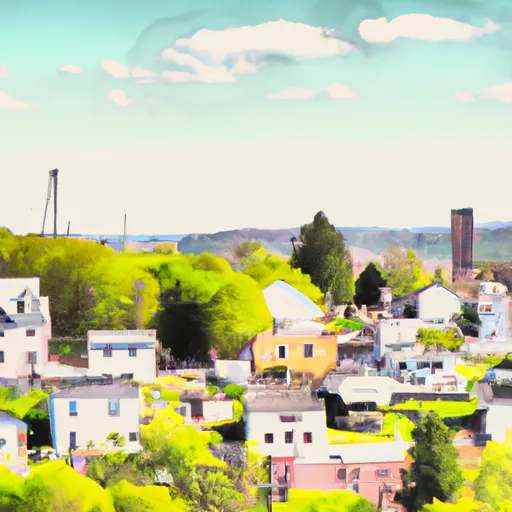-
 Snoflo Premium
Snoflo Premium
Get unlimited access to all our content
With no Ad interruptions! - Start Your Free Trial Login with existing account
Rector
Eden Index
Climate
7.3
•
Recreation
4.1
•
Community
•
Safeguard
4.3/10

Rector, Pennsylvania is a small community located in Westmoreland County, in the United States. The climate in Rector is classified as humid continental, characterized by warm summers and cold winters. Average temperatures range from around 20°F (-6°C) in winter to approximately 80°F (27°C) in summer. The area experiences moderate precipitation throughout the year, with slightly higher amounts during the summer months.
Rector is known for its picturesque natural surroundings, including various hydrology constituents. The Loyalhanna Creek flows through the region, offering opportunities for fishing, kayaking, and canoeing. Additionally, there are several nearby lakes and reservoirs, such as the Linn Run State Park and the Laurel Hill State Park, which provide opportunities for boating, swimming, and other water-based activities.
Outdoor enthusiasts visiting Rector can also enjoy hiking and camping in the nearby Laurel Highlands, which boasts beautiful trails, including the popular Laurel Highlands Hiking Trail. This area is known for its stunning landscapes, including waterfalls, forests, and scenic overlooks.
Overall, Rector, Pennsylvania offers a diverse range of outdoor recreational opportunities amidst its charming rural setting, making it an appealing destination for nature lovers and adventure seekers.
What is the Eden Index?
The Snoflo Eden Index serves as a comprehensive rating system for regions, evaluating their desirability through a holistic assessment of climate health, outdoor recreation opportunities, and natural disaster risk, acknowledging the profound impact of these factors on livability and well-being.
Climate Health Indicator (CHI): 7.3
Rector receives approximately
1231mm of rain per year,
with humidity levels near 83%
and air temperatures averaging around
10°C.
Rector has a plant hardyness factor of
5, meaning
plants and agriculture in this region thrive during a short period during spring and early summer. Most
plants will die off during the colder winter months.
By considering the ideal temperature range, reliable water supplies, clean air, and stable seasonal rain or snowpacks, the Climate Health Indicator (CHI) underscores the significance of a healthy climate as the foundation for quality living.
A healthy climate is paramount for ensuring a high quality of life and livability in a region, fostering both physical well-being and environmental harmony. This can be characterized by ideal temperatures, reliable access to water supplies, clean air, and consistent seasonal rain or snowpacks.
Weather Forecast
Streamflow Conditions
Allegheny
Area Rivers
Allegheny
Snowpack Depths
Allegheny
Reservoir Storage Capacity
Allegheny
Groundwater Levels
Recreational Opportunity Index (ROI): 4.1
The Recreational Opportunity Index (ROI) recognizes the value of outdoor recreational options, such as parks, hiking trails, camping sites, and fishing spots, while acknowledging that climate plays a pivotal role in ensuring the comfort and consistency of these experiences.
Access to outdoor recreational opportunities, encompassing activities such as parks, hiking, camping, and fishing, is crucial for overall well-being, and the climate plays a pivotal role in enabling and enhancing these experiences, ensuring that individuals can engage in nature-based activities comfortably and consistently.
Camping Areas
| Campground | Campsites | Reservations | Toilets | Showers | Elevation |
|---|---|---|---|---|---|
| New Germany State Park | 48 | 2,565 ft | |||
| Lost Land Run - Potomac State Forest | 6 | 2,367 ft | |||
| Mill Run - Youghiogheny River Lake | None | 1,565 ft | |||
| Big Run State Park | 29 | 1,492 ft | |||
| Wallman/Laurel Run - Potomac State Forest | 16 | 2,171 ft | |||
| Tub Run Rec Area - Youghiogheny River Lake | 101 | 1,583 ft | |||
| Deep Creek Lake State Park | 112 | 2,583 ft | |||
| Swallow Falls State Park | 65 | 2,418 ft | |||
| Robert W. Craig - Jennings Randolph Lake | 82 | 1,916 ft | |||
| Savage River State Forest Dispersed | 52 | 2,403 ft |
Nearby Ski Areas
Catastrophe Safeguard Index (CSI):
The Catastrophe Safeguard Index (CSI) recognizes that natural disaster risk, encompassing floods, fires, hurricanes, and tornadoes, can drastically affect safety and the overall appeal of an area.
The level of natural disaster risk in a region significantly affects safety and the overall livability, with climate change amplifying these risks by potentially increasing the frequency and intensity of events like floods, fires, hurricanes, and tornadoes, thereby posing substantial challenges to community resilience and well-being.
Community Resilience Indicator (CRI):
The Community Resilience Indicator (CRI) recognizes that education, healthcare, and socioeconomics are crucial to the well-being of a region. The CRI acknowledges the profound impact of these elements on residents' overall quality of life. By evaluating educational resources, healthcare accessibility, and economic inclusivity, the index captures the essential aspects that contribute to a thriving community, fostering resident satisfaction, equity, and social cohesion.

